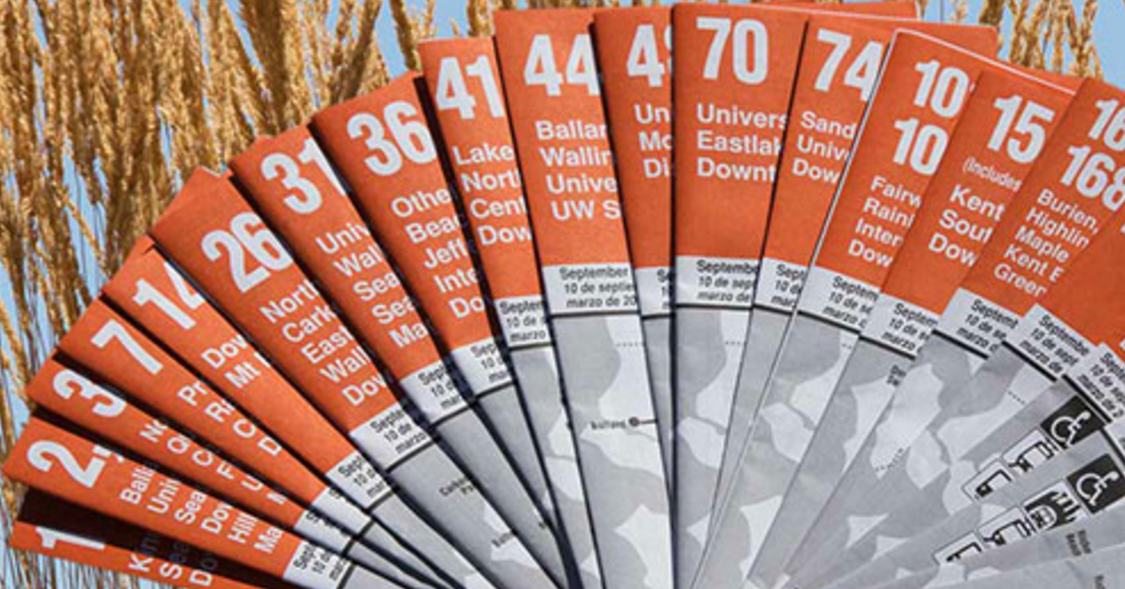King County Metro Transit is about to unleash the last service change of 2016. Starting in 2017, Metro timetables and service changes will only be implemented twice per year as opposed to the three times per year that we have seen in years past. In general, this season Metro is tweaking service across Seattle, Vashon Island, Redmond, and pretty much everywhere else in between with changes taking effect starting September 10th. As with most service changes, there’s some good and some bad.
North Seattle Lemonade
Bowing to pressure from riders reeling from the bungled Bus2Link restructure, Metro is adding extra service in North Seattle. Most of the changes are weekday peak-hour improvements and schedule adjustments, but a few will provide valuable Sunday service which was all but demolished in the restructure.
Route 26X will see modest frequency improvements during the 8am hour on weekdays with two trips leaving southbound from Green Lake instead of the Northgate Transit Center origin point. One of those southbound trips will be converted from the existing schedule, leaving Northgate riders with one less morning trip. Metro will also revise a small portion of the route near North Seattle Community College.
Route 28 will get minor schedule adjustments during weekday morning and evening peak hours, although one afternoon northbound trip will no longer serve Broadview. On weekends, on southbound morning trip (6.33am) will be deleted.
Route 48 will get two southbound trips added during weekday mornings and one northbound trip added during the late evening.
Route 45 will see reduced early-morning service on weekdays with the 5.21am and 5.50am trips to University of Washington Station being consolidated into one trip at 5.35am. Minor adjustments will be made for trips after 10pm on weeknights and after 11.30pm on weekends to better align with Link.
Route 62 will get a one-trip boost during the weekday morning rush offering minimal relief to cramped conditions down the line. Other minor schedule adjustments will be made. Inexplicably, Metro is not planning to fix the nightmare weekend and nighttime routing in Northeast Seattle–an unforgivable decision–that is killing ridership on its eastern tail.
Route 63 will get one extra morning trip.
Route 65 will see some love with the upping of daytime Sunday frequency from every 30 minutes to every 20. A few trips will be added during the weekday afternoon peak to increase frequency from every 10 minutes to every 7.
Route 67 will get similar improvement to Route 65. Daytime Sunday service will be boosted to every 20 minutes, up from every 30. Morning and evening weekday peak hours will improve to every 10 minutes in the peak direction (southbound in the morning and northbound in the afternoon).
Route 71 will merely get minor schedule adjustments leaving riders to still hangout and dry on Sundays.
Route 73 will get all-day Sunday service with a frequency of every 30 minutes where it has none today. The route will operate from 7.45am to 7.15pm.
Route 77 will get two extra trips in the morning and two extra trips in the afternoon.
Route 372 will see a variety of weekday service improvements, including an extra southbound morning trip, removal of the “UW Reduction” designation from select afternoon trips, and overall service frequency increases of peak-direction trips during peak hours. A new stop pair will also be added at NE 60th St on 25th Ave NE.
Route 373 will serve a new stop pair at NE 70th St on 15th Ave NE.
Southeast Seattle Shakedown
Metro is barreling toward another bungled restructure in Southeast Seattle, in part to appease the Asian Counseling and Referral Service (ACRS) in the International District that lost a direct connection to the Rainier Valley when the unicorn Route 42 was deleted. The meat of the restructure is depressing service on the Route 9X, deleting the Route 38 and replacing it with Route 106, and rejiggering Routes 107 and 124. We spilled a fair bit of ink on this restructure earlier in the year, especially in regards to the Georgetown problem. But let’s recap on how the changes will work.
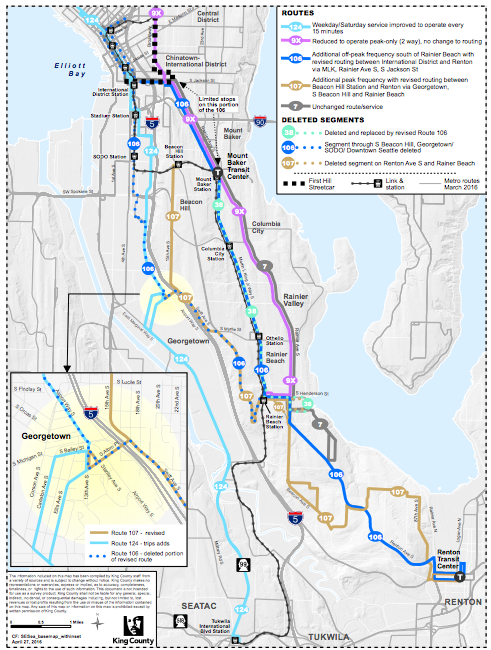
First of all, the barely six-month-old Route 38–the result of splitting the Route 8 at Mount Baker Transit Center–will meet its early death in the service change. Replacing it be the Route 106 that operates from Renton to Downtown Seattle. No longer serving Georgetown, the 106 instead will operate through the Rainier Valley and head toward the International District before continuing through Downtown. Making up for the loss of all-day service that the 106 provided on the way to Georgetown, Metro proposes to extend the Route 107 through New Holly and South Beacon Hill, and briefly loop into Georgetown. The route extension would also run the service up to Beacon Hill Station, which partially duplicates the Route 60, but also provides unique connections. To make all of this remotely palatable, Metro will boost the frequency of Route 124 through Georgetown to every 15 minutes throughout some of the day–but during peak, where the 106 already operates at that frequency, it will be a loss of trips between the heart of Georgetown and Downtown.
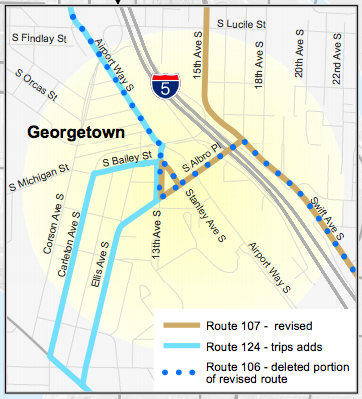
But the real poison in the punch for Georgetown riders is the lack of beefed up hours on the 124 to extend into the evening–after 8pm, just two trips per hour will make the journey between Airport Way, a major nightlife destination, and downtown. The confusing dogleg of the 107 will only be able to be utilized by the most studious riders in Georgetown; the rest will take a taxi when they realize their bus is 30 minutes out. Meanwhile, the 106’s new routing will have limited stops through to the International District, which truly begs what sort of utility it will offer over existing service or light rail. And let’s not forget: Metro is essentially putting the Route 9X on the chopping block by turning it into a peak-only route. The 9X, providing a direct connection between the Rainier Valley and Capitol Hill, is just the sort of crosstown route that Metro’s long range plan is full of–let this be a lesson in how quick Metro is to kill a route like that to score political points.
Perhaps most frustrating to Seattle voters is that the restructure essentially adds zero value to the network while poaching Proposition 1 dollars to make it work. Metro calls this a “partnership,” but it would be better called a “waste of tax dollars.” Georgetown’s added service on the 124–such as it is–is only guaranteed until the Proposition 1 funds run out, so Georgetown could be looking at even fewer service hours in a few years.
Seattle’s Smorgasbord of Other Route Revisions
Metro will add trips to other select routes in Seattle to reduce overcrowding thanks to the funding provided by Proposition 1 tax dollars. The lucky routes to get modest boosts include Routes 8, 15, 18, 21, 40, and 120:
Route 8 will get one new southbound trip during the 6pm hour and minor schedule adjustments to accommodate it.
Route 15 will get one new southbound trip during the 8am hour.
Route 18 will get one new morning trip, which will create cascading trip adjustments for both Route 17 and Route 18.
Route 21E will get a new northbound morning trip.
Route 40 will get minor frequency improvements in the peak direction in both the morning and evening during peak hours.
Route 120 will get a very early morning trip (4.37am) headed northbound. Minor schedule adjustments will also be made to select morning departures.
Other less consequential changes–unless you’re a hospital on Pill Hill–are also being rolled out to Seattle-oriented routes:
Route 27 will operate on a revised route.
Route 33 will be through-routed with Route 124 on weekdays and Saturdays.
Routes 111, 114, 177, 178, and 190 will have a minor terminal change in Downtown Seattle in the northbound direction.
Route 131 will get a minor weekday schedule adjustment to make up for the loss of one trip during the 8am hour.
Route 132 will see the deletion of one early morning trip on weekends.
Routes 193 and 303 will have a minor route revision to consolidate First Hill service to 9th Avenue instead of being sent on loops.
Route 316 will get a minor schedule revision for the 6am hour.
Route 345 will operate on a revised route near North Seattle College.
Vashon, Redmond, and Beyond–We’ll Get You There
It’s been a long time, but Vashon’s cross-island route (Route 118) is about to see Sunday service reintroduced. Metro plans to use the same schedule as Saturday to connect riders with the ferry timetables. It’s a small prize, but there’s no doubt that islanders and visitors afar will appreciate the skeleton service. Meanwhile, its sister route (Route 119) will get a minor schedule adjustment for an evening departure from Dockton.
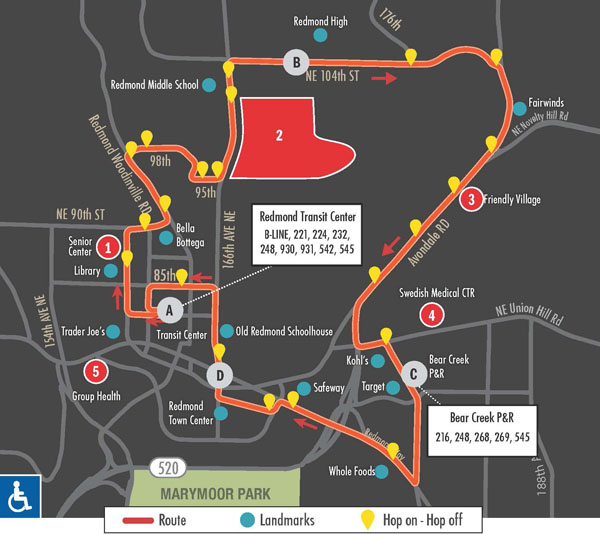
Redmond will also get some goods, due in part because of a partnership with Metro to pilot a new local service called the “Redmond LOOP,” but also because a new express will be commissioned. Redmond already had a soft launch for the Redmond Loop, which began in June. The loop provides one-way service through the city center and civic core, residential neighborhoods to the north and east, and the industrial wing at the southend of the city. Buses operate every 45 from 9am to 3pm on weekdays. Redmond will also benefit from a new weekday peak-hour route (Route 243) that will operate from Overlake Transit Center to Kenmore P&R via Downtown Redmond, Totem Lake, and UW Bothell. The route will head in the northbound direction in morning and southbound direction in the afternoons.
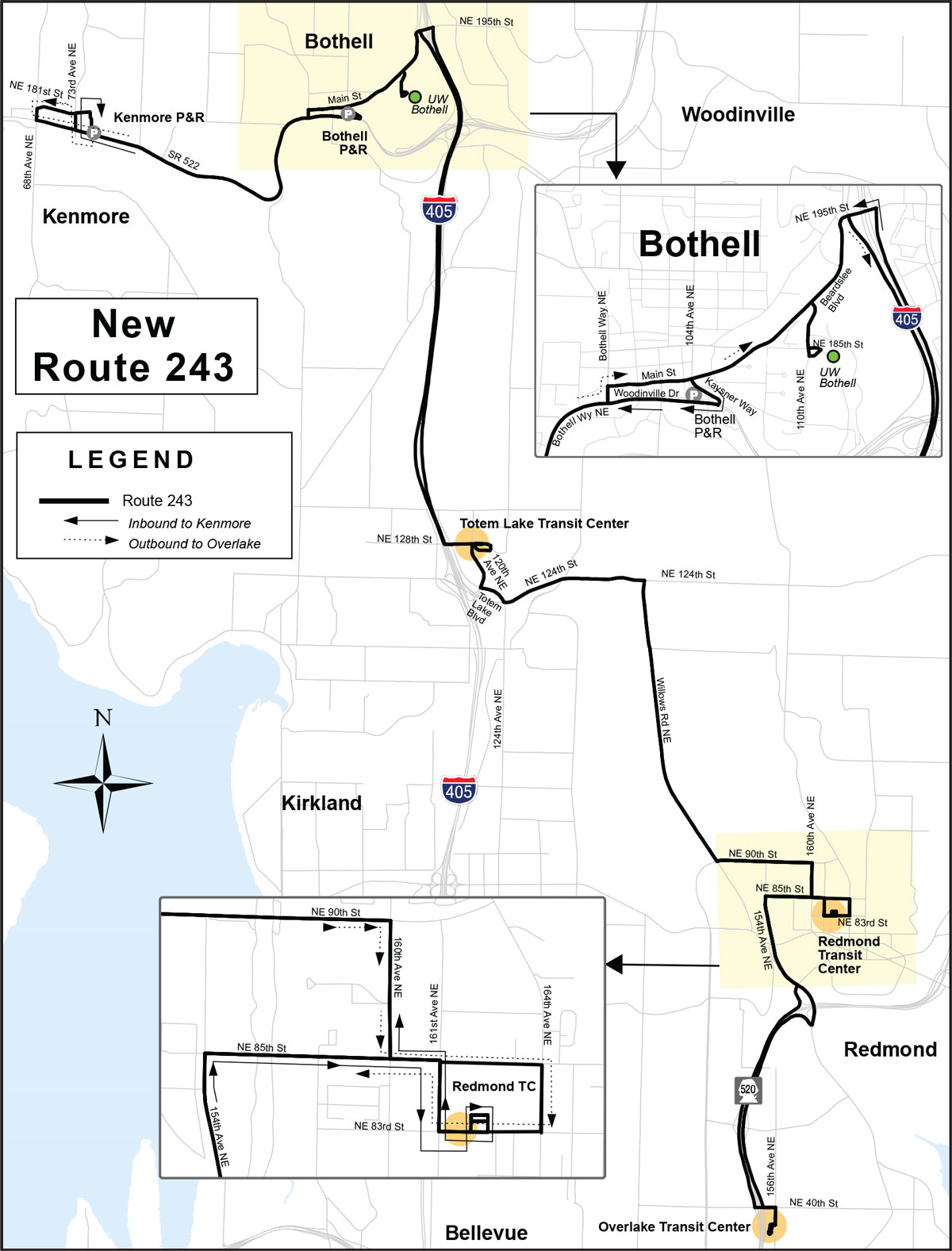
Route 249 will operate on a revised routing due to East Link construction.
Route 915 (DART) will get a minor terminal adjustment in Enumclaw. In essence, the route tail will be extended eastward to match the routing of Route 186 during the morning peak.
So that’s what’s in store for Metro’s September service change. Tune in next time for more in the saga of developing a navigable bus system.
Ryan Packer has been writing for The Urbanist since 2015, and currently reports full-time as Contributing Editor. Their beats are transportation, land use, public space, traffic safety, and obscure community meetings. Packer has also reported for other regional outlets including BikePortland, Seattle Met, and PubliCola. They live in the Capitol Hill neighborhood of Seattle.

